Disclaimer: This post may contain Amazon affiliate links. Sudachi earns a small percentage from qualifying purchases at no extra cost to you. See disclaimer for more info.
Featured Comment:
“Thank you for this recipe. I have been looking for this for over a year. And now i found yours. I made it yesterday and could not put it down. So good, just perfect. But, i made a sugarfree version of it. So, i used almond milk and heavy cream, with the eggs and gelatine, with stevia drops. And minimal effort too.”
– Michelle
What is “Purin”?
Purin is a popular Japanese dessert made with a sweet custard-jelly served with a thin layer of delicious caramel. There are many different variations of custard pudding all over the world and it goes by many different names such as flan, creme caramel, custard pudding or caramel custard. In Japan, we simply call it “purin”.
This dessert is popular with kids and adults and is one of Japan’s most well loved sweet treats. You can find it in any convenience store or supermarket and there are many kinds to choose from!
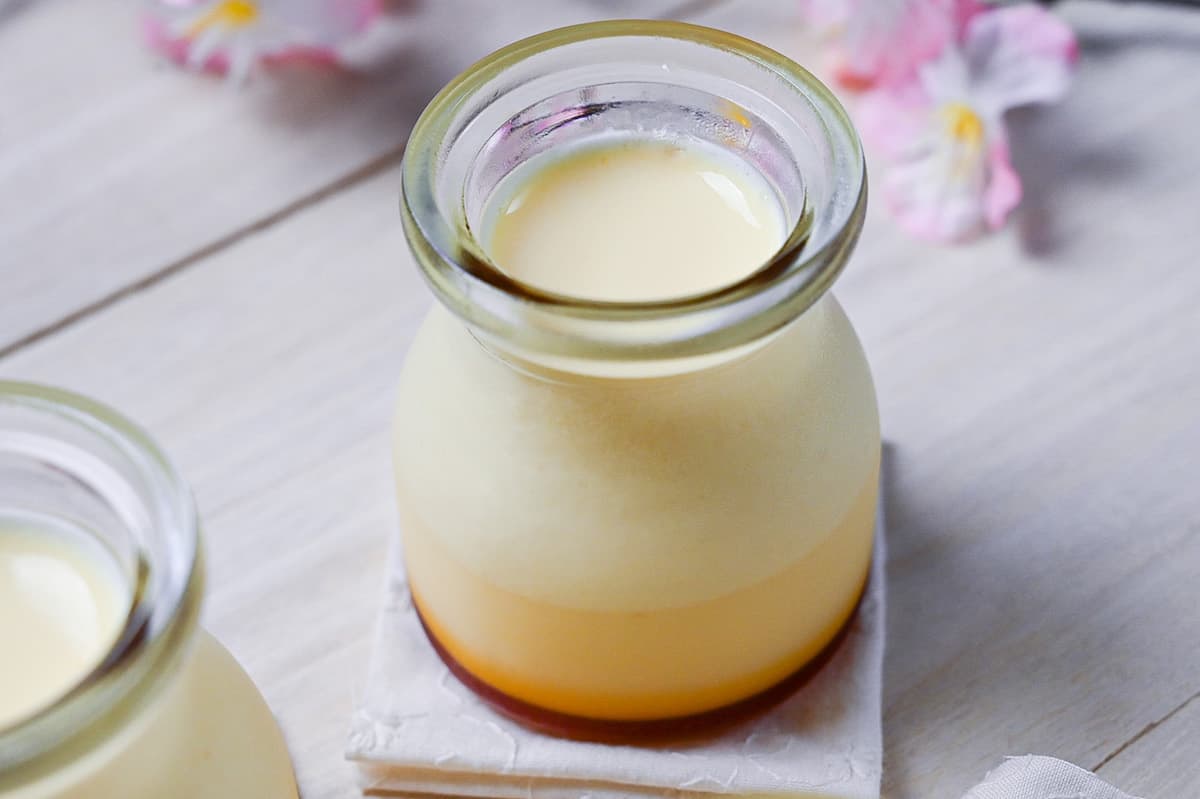
Ingredients You Will Need
- Granulated sugar – to make the caramel and sweeten the custard.
- Pasteurised eggs – since the eggs aren’t fully cooked in this recipe, I recommend using pasteurised eggs that are safe to eat raw (all eggs in Japan are treated and eaten raw regularly). For more information about egg safety, see the American egg board website.
- Whole milk – the best for making custard!
- Double cream (38% fat or more) – to make the taste richer and creamier.
- Vanilla essence – a classic flavour for custard! (If using vanilla extract, use half!)
- Powdered gelatine – to set the custard.
Curious about the exact brands and products that bring my recipes to life? Discover the brands and ingredients behind my recipes at the Sudachi Amazon Storefront. Explore my handpicked pantry essentials and find your next kitchen favorites!
Jump to Full Recipe Measurements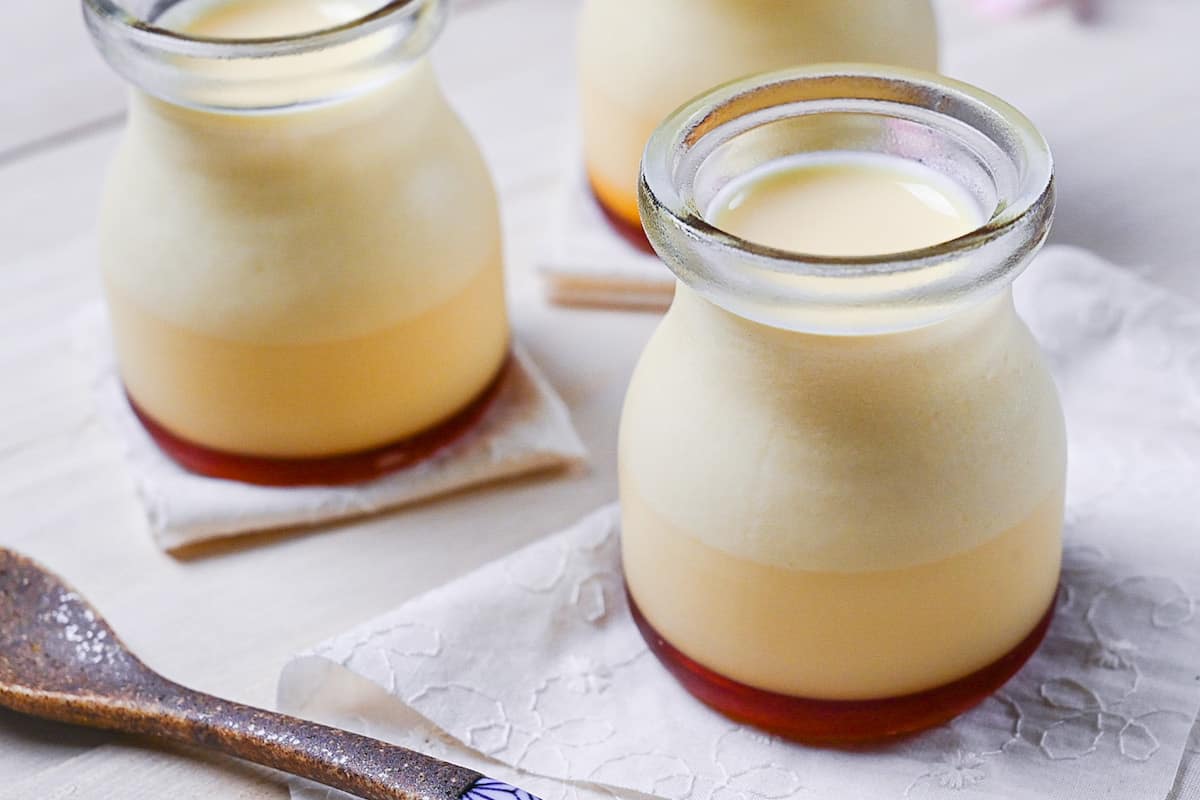
Recommended Pudding Cups
One of the most iconic features of Japanese style purin, is the cups that they are served in. They’re almost like miniature milk bottles.
If you live in Japan, it’s easy to find these purin cups in 100 yen stores (Japanese version of a dollar store) but if you live outside of Japan, you can also order them from Amazon like these ones here.
I recommend using glass jars rather than plastic because in my recipe, I pour hot caramel into the container.
This recipe makes about 550-600ml of purin mixture, I recommend using 6 x 100ml purin cups (3.5 fluid oz) for the best caramel to custard ratio, but alternatively you can also make 4 x 150ml (5.5 fluid oz) containers.
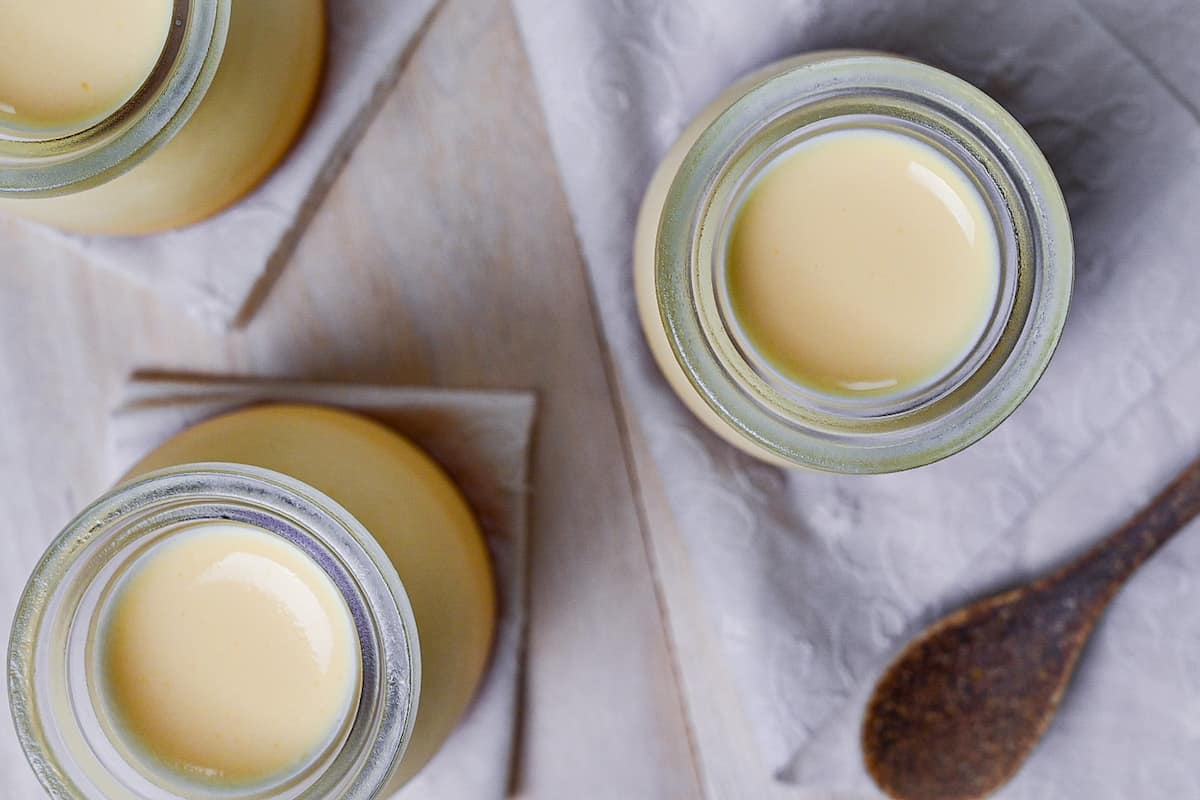
Visual Walkthrough & Tips
Here are my step-by-step instructions for how to make Japanese Nameraka Purin at home. For ingredient quantities and simplified instructions, scroll down for the Printable Recipe Card below.
The first step is to pour the milk, sugar and gelatine powder into a microwavable jug for easy pouring later.
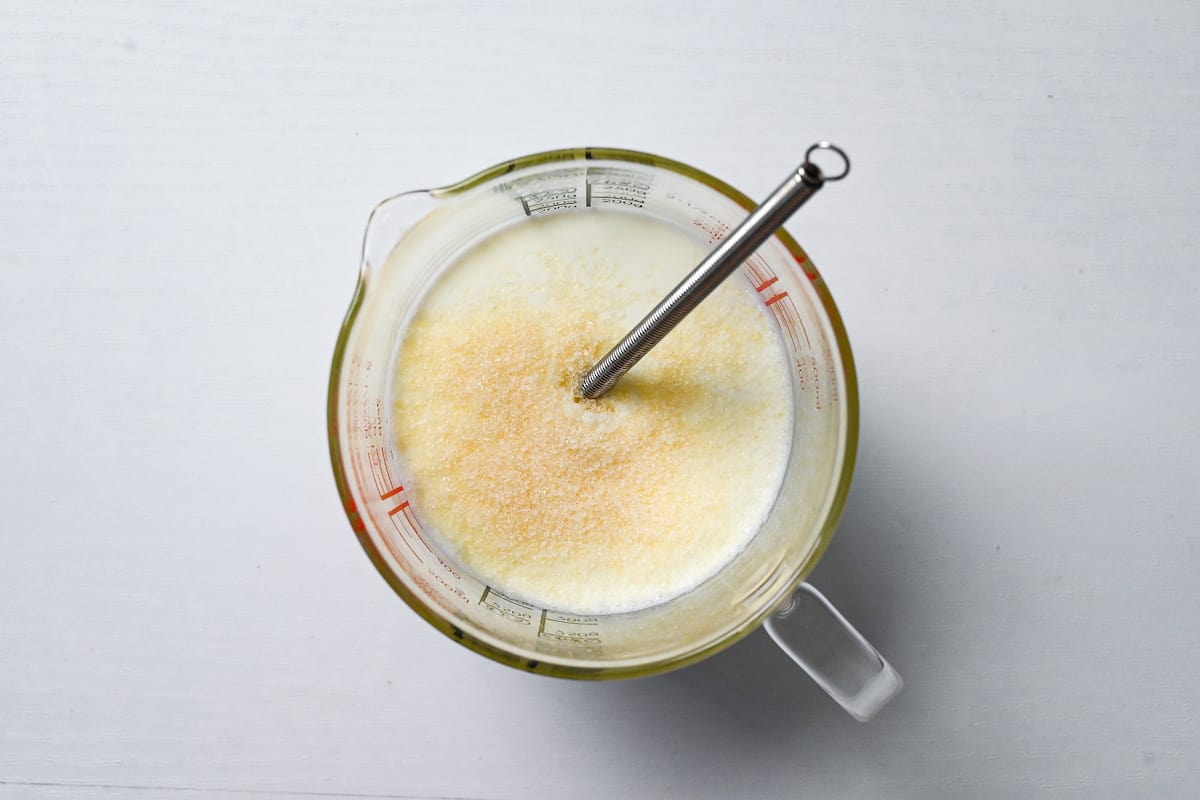
You will need to wait 5-10 minutes for the gelatine granules to “bloom.” I use this waiting time to make the caramel.
Tip: Sprinkling the gelatine powder over the milk (rather than pouring the milk over a heap of gelatine powder) will help prevent clumps of gelatine from sticking together!
This recipe’s next and probably most difficult part is making the caramel.
- Use a silver pan (not black) so you can easily see when the caramel changes color
- Heat on medium/medium-low so that it doesn’t brown too quickly and burn
- Do not stir (this can cause crystallization); instead, tilt and swirl the pan from time to time to prevent burning.
- Add the water one-third at a time (this cools the caramel and prevents burning).
- Stand back and wear oven gloves when you add the water as it might sizzle and splash.
- Pour the caramel into the containers while it’s still hot
Start by mixing the sugar and a third of the water in a cold saucepan.
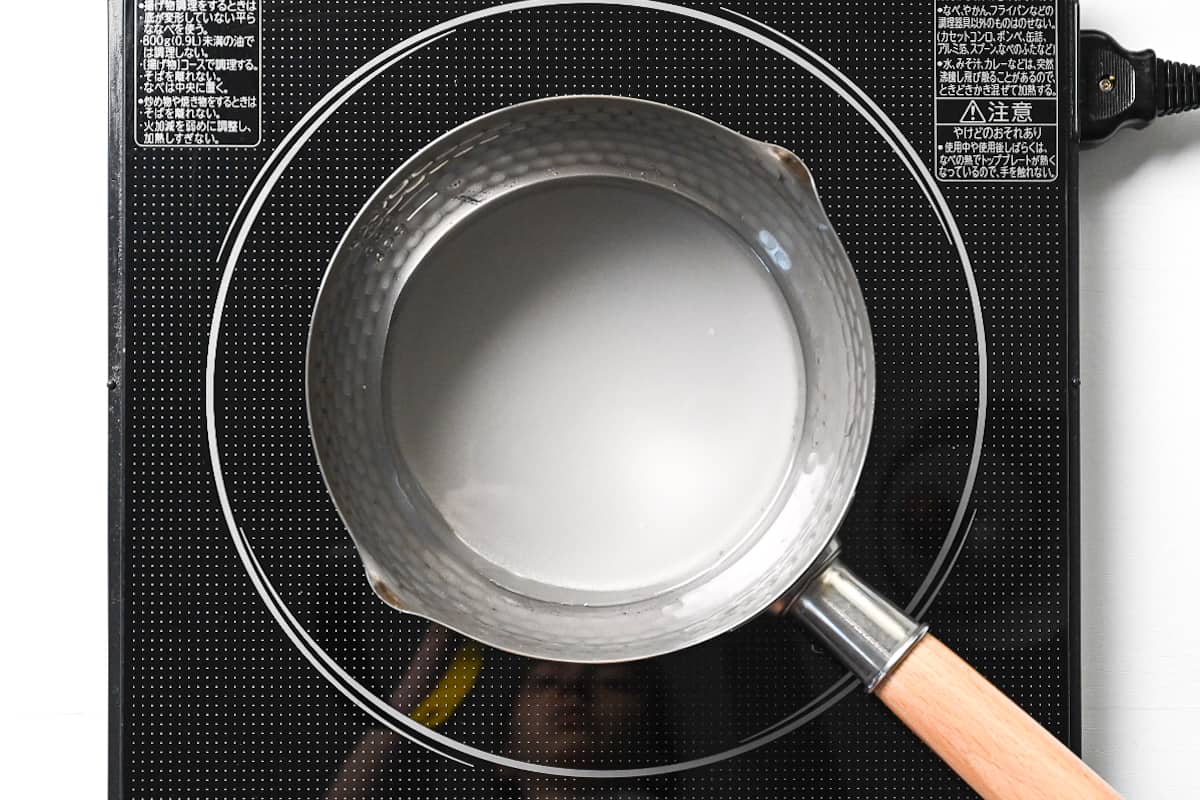
Once it’s mixed, place it on the stove and heat it to medium/medium low. It might change color quickly in some areas due to heat spots on your stove or pan, so swirl it gently or tilt the pan to cook it evenly. Do not stir it once it’s bubbling, as this can cause the caramel to crystallise.
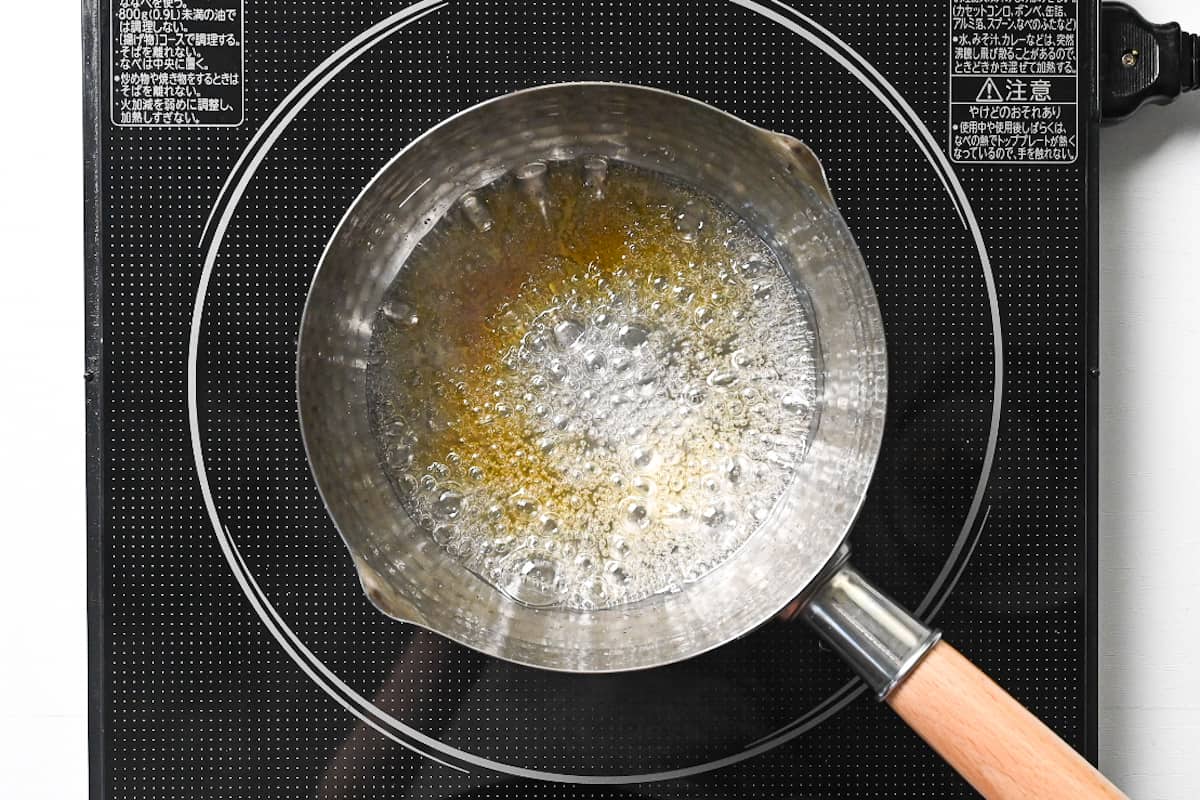
When the sugar and water start to become a little golden, add another third of the cold water. (Be careful of the caramel splashing and sizzling; I recommend standing back and wearing oven mitts to protect your hands.)
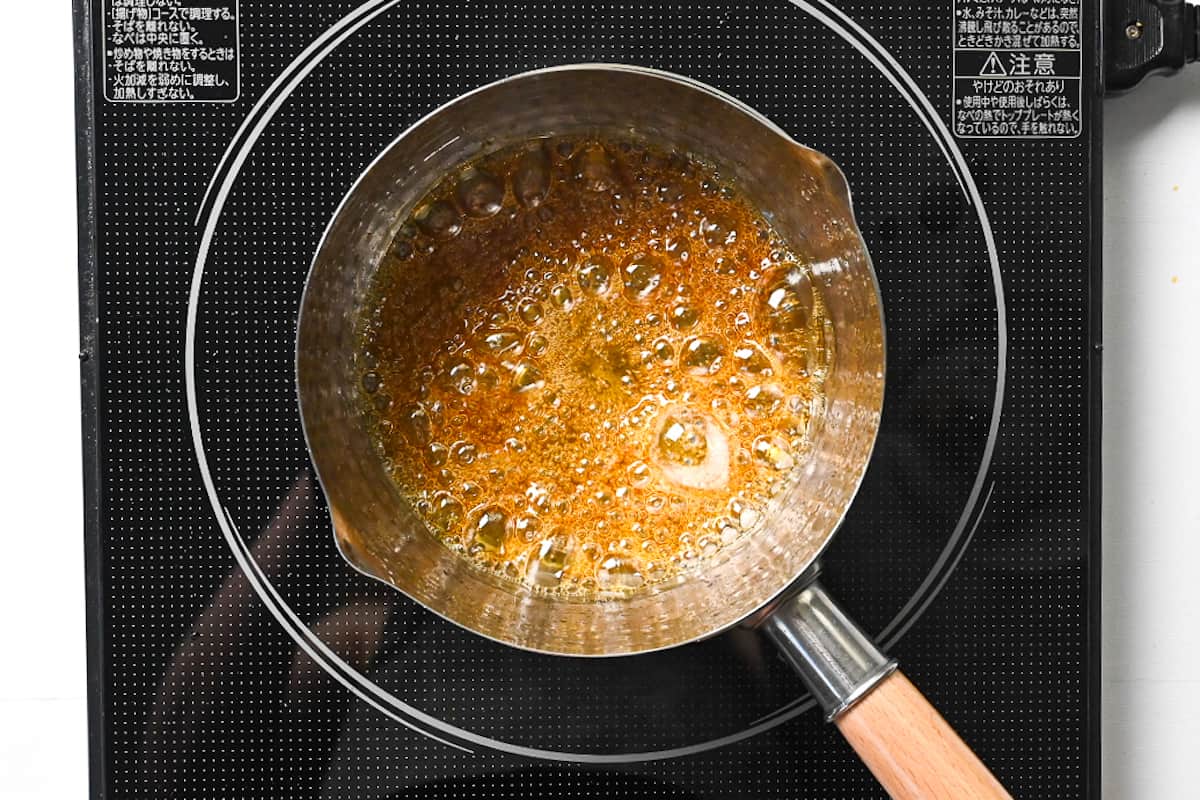
Continue to swirl or tilt the pan when necessary, and add the last third of water once the caramel turns amber.
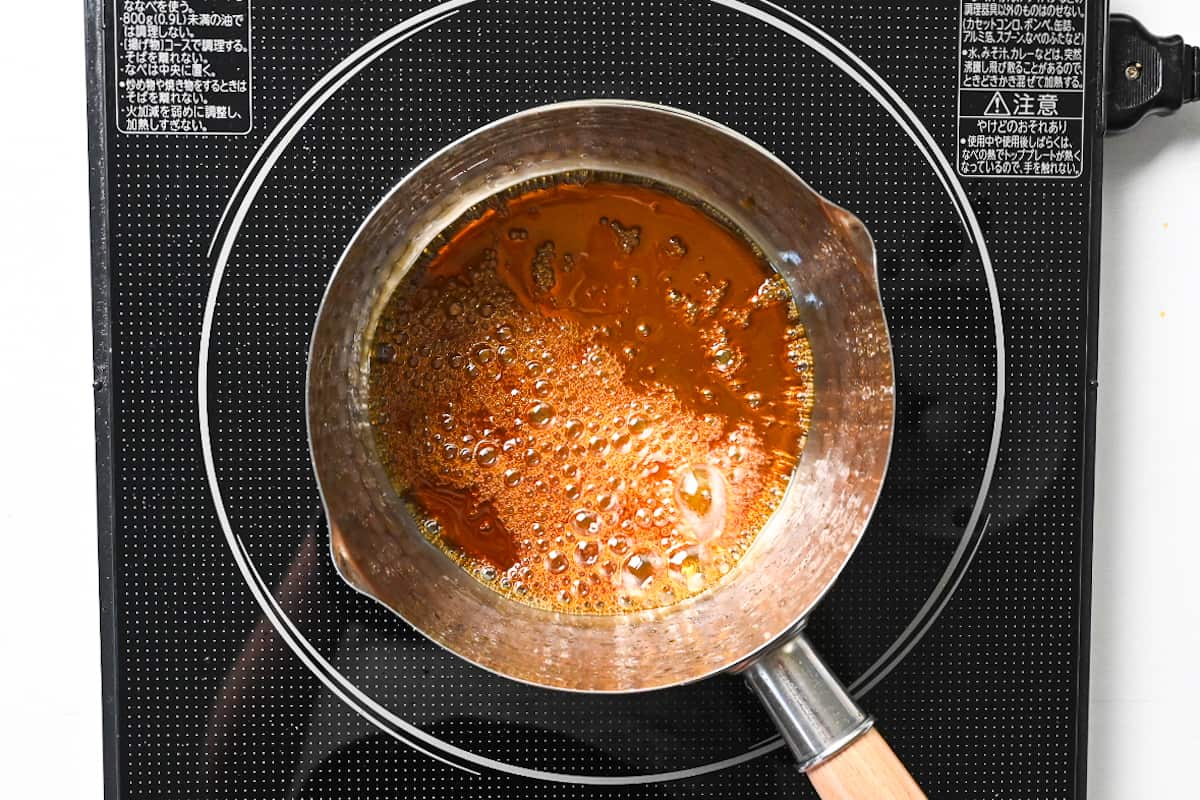
Remove the pan from the heat and swirl it around to help cool it down slightly. Then pour it into your heatproof purin containers and set aside for later.
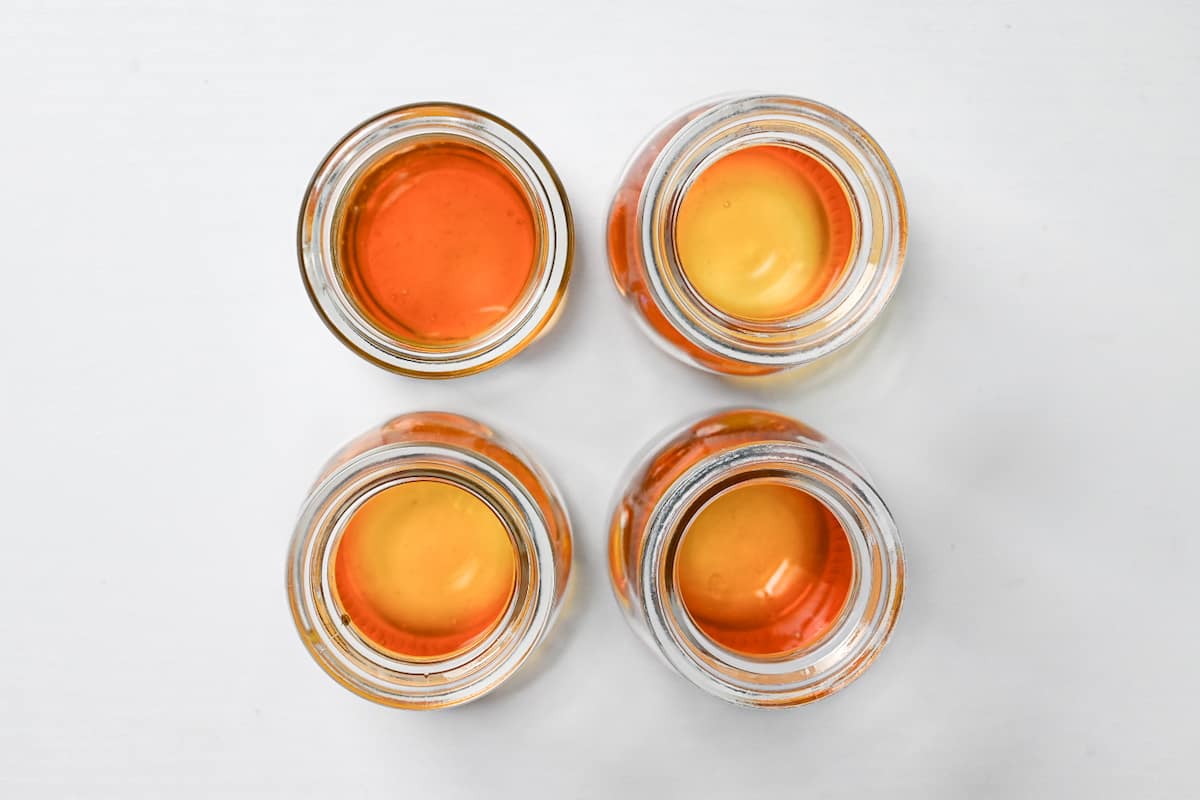
Once they’ve cooled, feel free to store them in the fridge to help set the caramel further.
Once the gelatine has “bloomed,” it’s ready to be melted. To avoid watering down the purin, I like to melt the gelatine directly in the milk. This means you have to be careful not to overheat the milk; otherwise, it might scold and create an unpleasant taste. At the same time, you need to heat it enough so that the gelatine powder melts.
Milk is best heated to around 60-70℃ (Approx 140-160°F). It’s also important to note that gelatine starts to lose its setting properties if heated above 75℃.
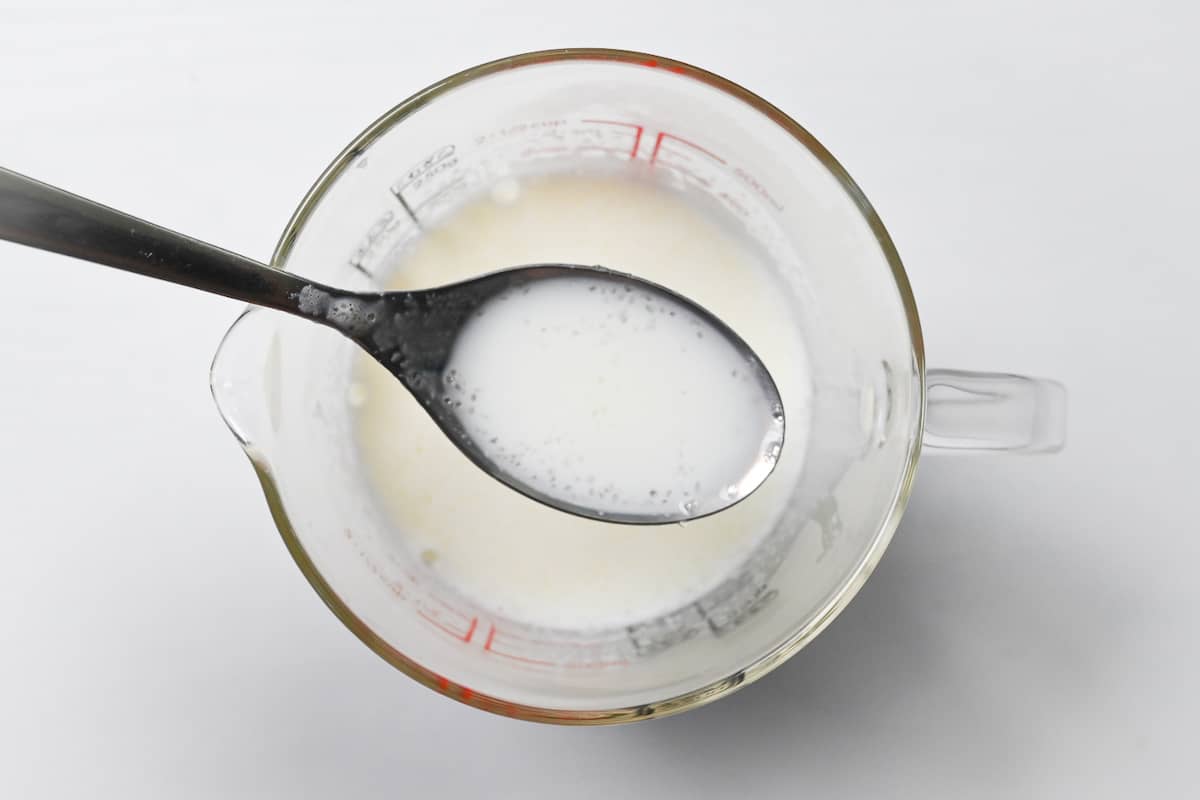
Start by microwaving the milk for 2 minutes at 600W. Mix it and then keep heating in 20-30 second intervals, mixing thoroughly each time. This should stop the milk from getting too hot and allow you to check to see if the gelatine is melted properly.
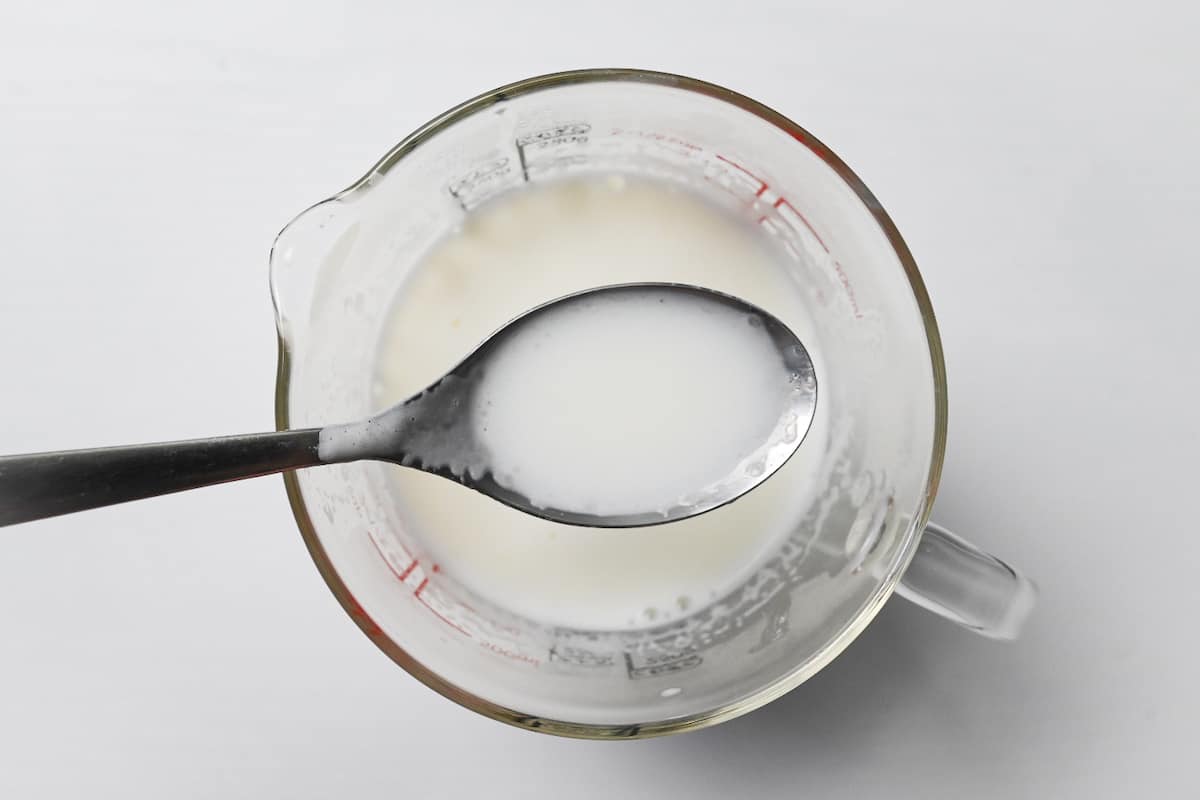
Alternatively, you can heat the milk in a saucepan on medium-low heat until the gelatine has melted. Just be careful not to let it boil and remove it from the heat if small bubbles start to form around the edge.
After microwaving the milk for 2 minutes, heat it in 20-30 second intervals, stirring each time. This will help prevent scalding the milk. Alternatively, heat it in a saucepan for more control.
Crack the eggs into a heatproof bowl and whisk until the yolks and whites are combined.
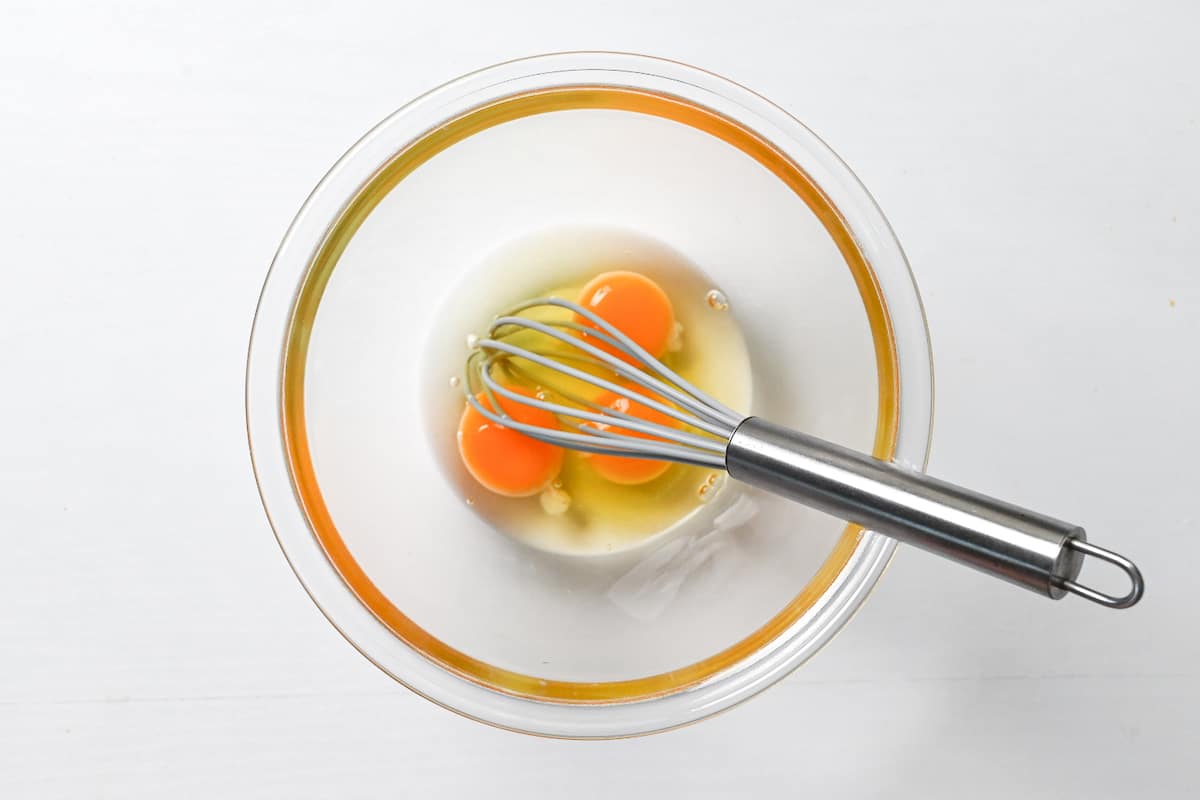
Next, add the heavy cream and vanilla essence and whisk again.
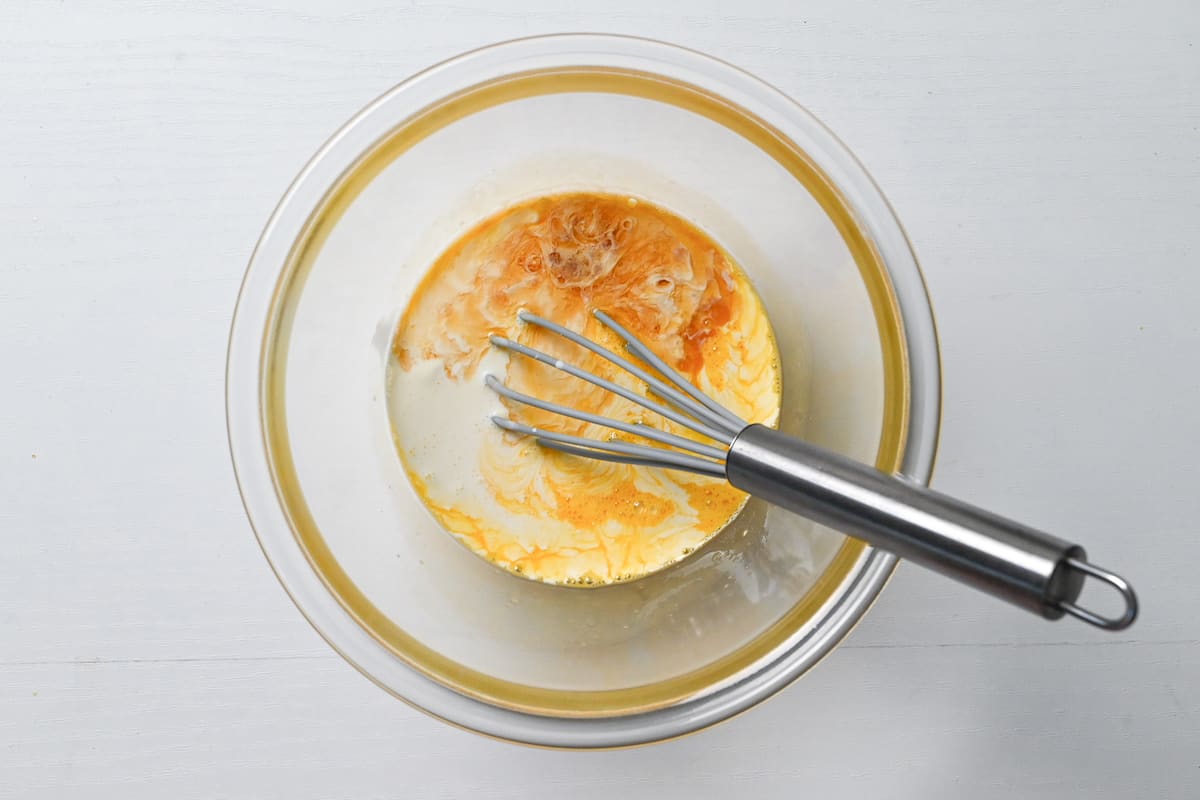
Once the eggs are whisked with the cream, add the hot milk. If you pour it in all at once, the eggs might cook and become scrambled. To avoid this, temper the eggs by adding a little bit of hot milk at a time. In the beginning, less is better; add it as gradually as possible while gently whisking.
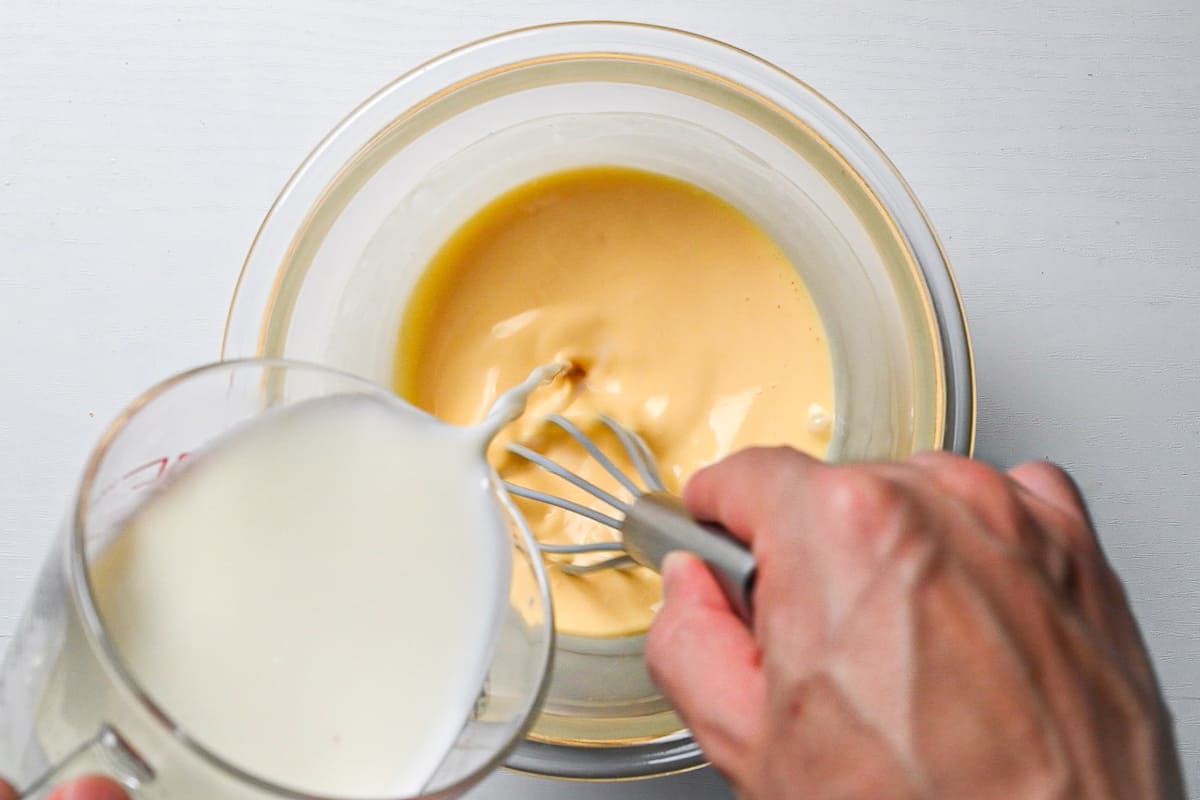
Prevent scrambled eggs by adding the hot milk little by little.
Once you’ve mixed everything, pour through a fine mesh sieve. This will catch any lumps of gelatine powder or egg that you might have missed, making your custard extra smooth and silky.
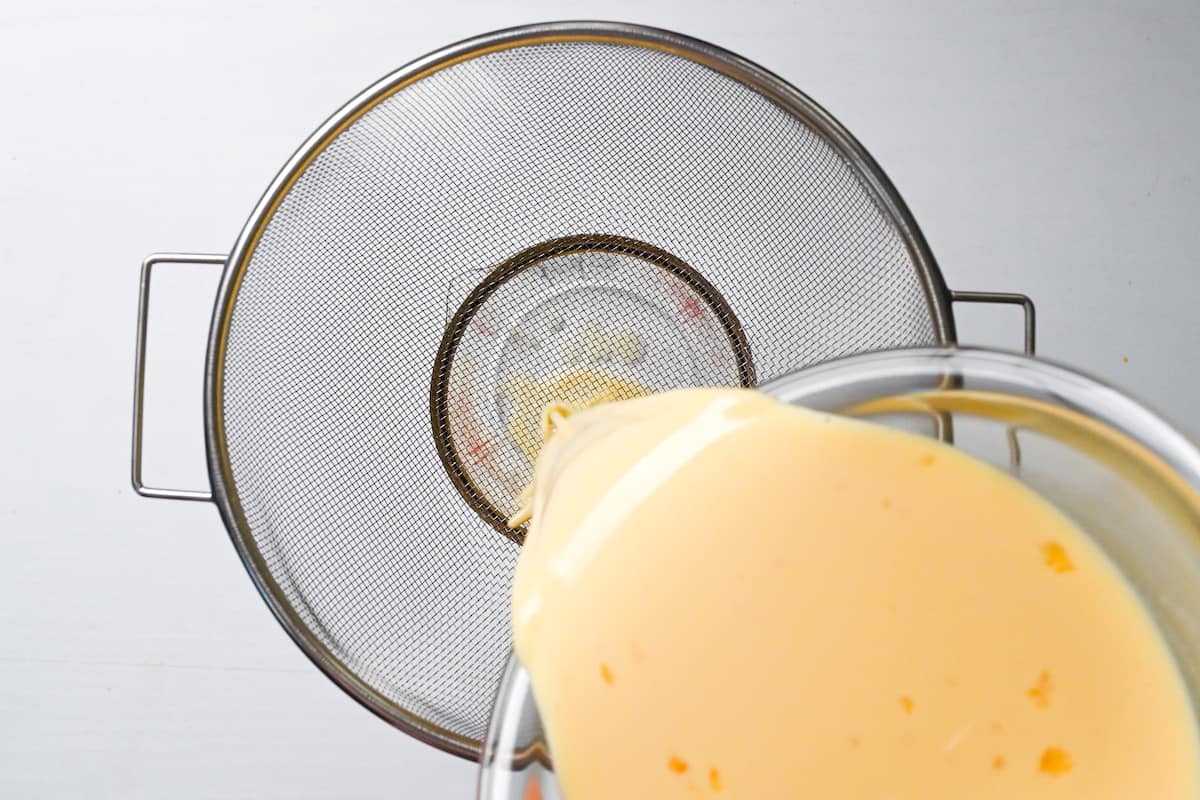
For the smoothest, silkiest purin, be sure to pour it through a sieve before pouring it into your containers!
Finally, pour the mixture into the purin cups over the caramel. Leave a little bit of space at the top to prevent spills.
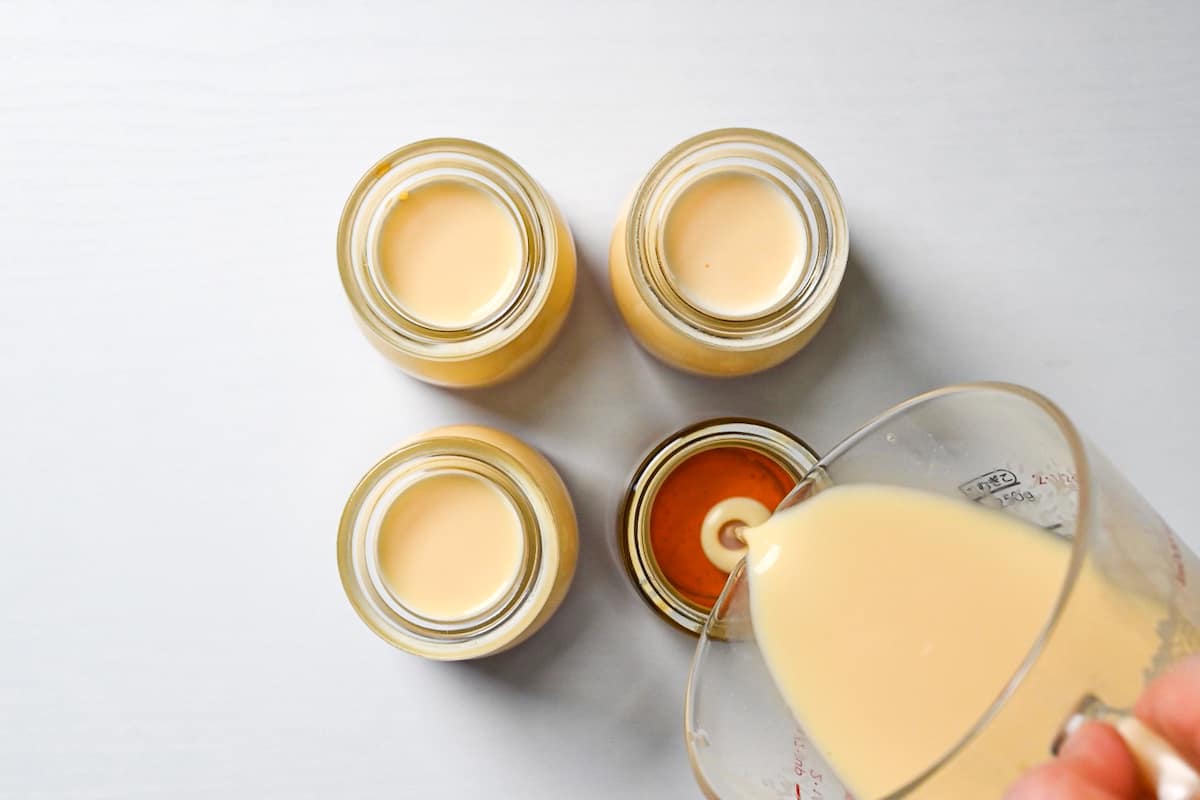
If your purin cups came with lids then place them on top, if not, seal the top with plastic wrap. Place them in the fridge and allow to chill until set.
Purin generally takes about 3-4 hours to set enough to eat. If possible, refrigerate overnight for the best texture and flavor.
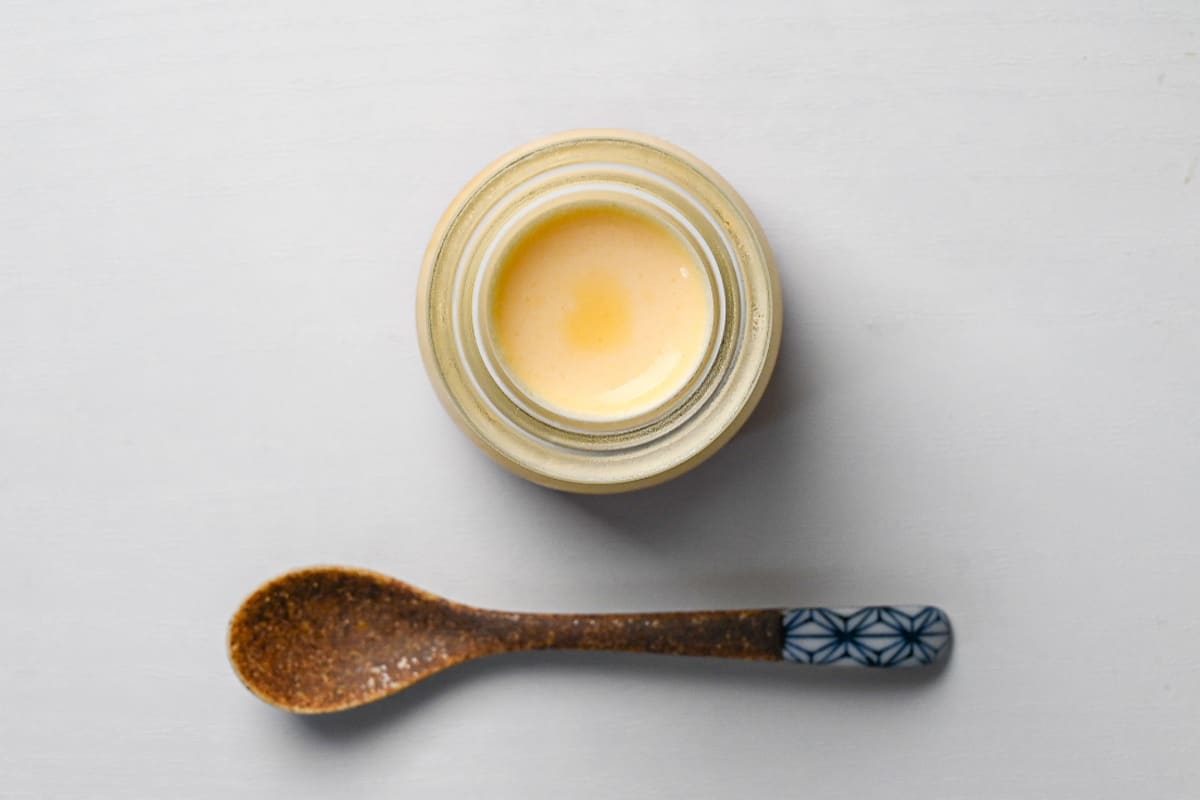
Enjoy this extra silky and creamy Japanese purin!
Jump to Full Recipe Measurements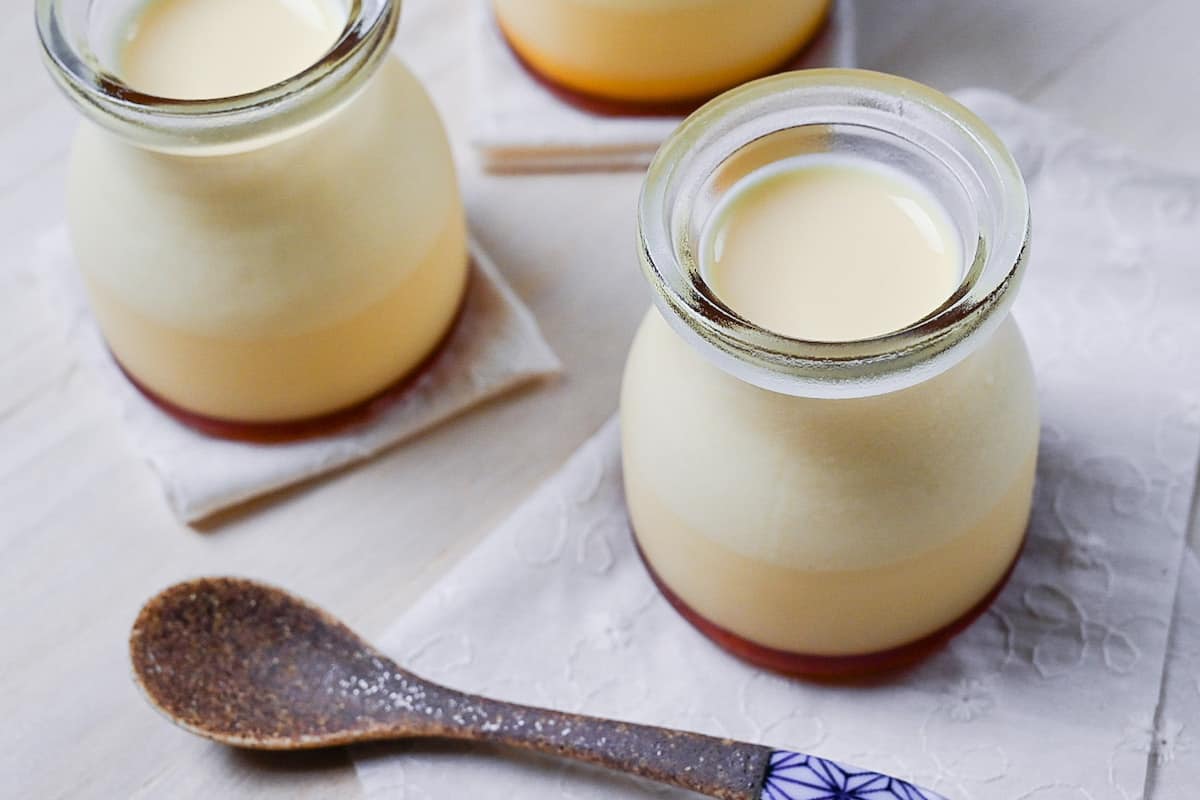
How to Store
Purin can be kept in a sealed container in the refrigerator for 2-3 days.
Freezing is not recommended.
FAQ
Here are answers to frequently asked questions I have received across all platforms, including here, YouTube, and Pinterest. If you have any questions, feel free to send them to me anytime! It will be a big help for everyone in this community!
It is said that pudding was introduced to Japan in the late Edo period (1603-1868) and early Meiji period (1868-1912). The name “purin” (プリン) comes from the English word “pudding” which was mentioned in a document from around 1872.
Purin gradually appeared on restaurant dessert menus and its popularity spread across Japan. In fact, it became so popular, that by the 60’s it had also become a common dessert to eat at home, either homemade or ready-made from supermarkets. Later on, not only steamed puddings but also baked puddings and puddings set with gelatine were introduced, expanding the variety of pudding textures.
To this day, purin is one of the most common desserts to eat in Japan!
There aremany ways to make, cook and flavor purin. Here are the main types of purin available in Japan:
1. Purin (プリン) Standard purin made with eggs, milk and caramel then set with gelatine. Some recipes contain heavy cream to make it thicker, richer and more decadent.
2. Mushi Purin (蒸しプリン) Steamed purin with a slightly firmer texture than regular purin.
3. Yaki purin (焼きプリン) Purin made by baking in the oven.
4. Katame Purin (固めプリン) A firm type of purin often turned out onto a serving dish with the caramel sitting on top.
5. Nameraka Purin (なめらかプリン) Soft purin served in a container usually with the caramel sitting at the bottom.
My recipe is for nameraka purin, which is my personal favorite. The texture is soft, silky and only just set which means it needs to be served in a container since it’s too soft to hold its shape on its own. Nameraka purin is so soft that it melts in your mouth, it’s seriously good!
In Japan, Purin has a wide variety of flavors! Some of them are available all year around, others appear depending on the season. For example, pumpkin and chestnut are often found in Autumn whereas mango and coconut are more likely to be found in summer. Here are a few other purin flavors you can find:
Matcha
Pumpkin
Chestnut
Sweet potato
Black sesame
Chocolate
Mango
Coconut
All of these interesting flavors just go to show how much Japanese people love purin! You can experiment with the flavors by switching out the vanilla essence for a different essence, extract or powder!
Purin and flan are both desserts made with set custard topped with caramel. They contain similar ingredients, however flan is more commonly baked to set the eggs whereas Japanese purin is more commonly set with gelatine. Baked purin in Japan is known as yaki purin. There is also a steamed variation known as mushi purin.
Mexican flan is often made with condensed milk and baked, whereas Japanese purin is more commonly made with milk, heavy cream and set with gelatine.
The storage time for purin depends on the recipe. Since my purin recipe contains uncooked eggs, I recommend consuming within 2 days. Baked or steamed purin will last longer.
While it is possible to freeze purin, I personally don’t recommend it for this recipe.
On the stove top, I recommend heating on low and gradually bringing the milk to 60 degrees celsius (140 Fahrenheit). A little lower is okay, but no hotter. If you don’t have a cooking thermometer, heat the milk until little bubbles form around the edge, but don’t let the milk boil. Stir continuously to make sure it doesn’t burn and mix until the gelatine has dissolved. From there, you can continue the steps as usual.
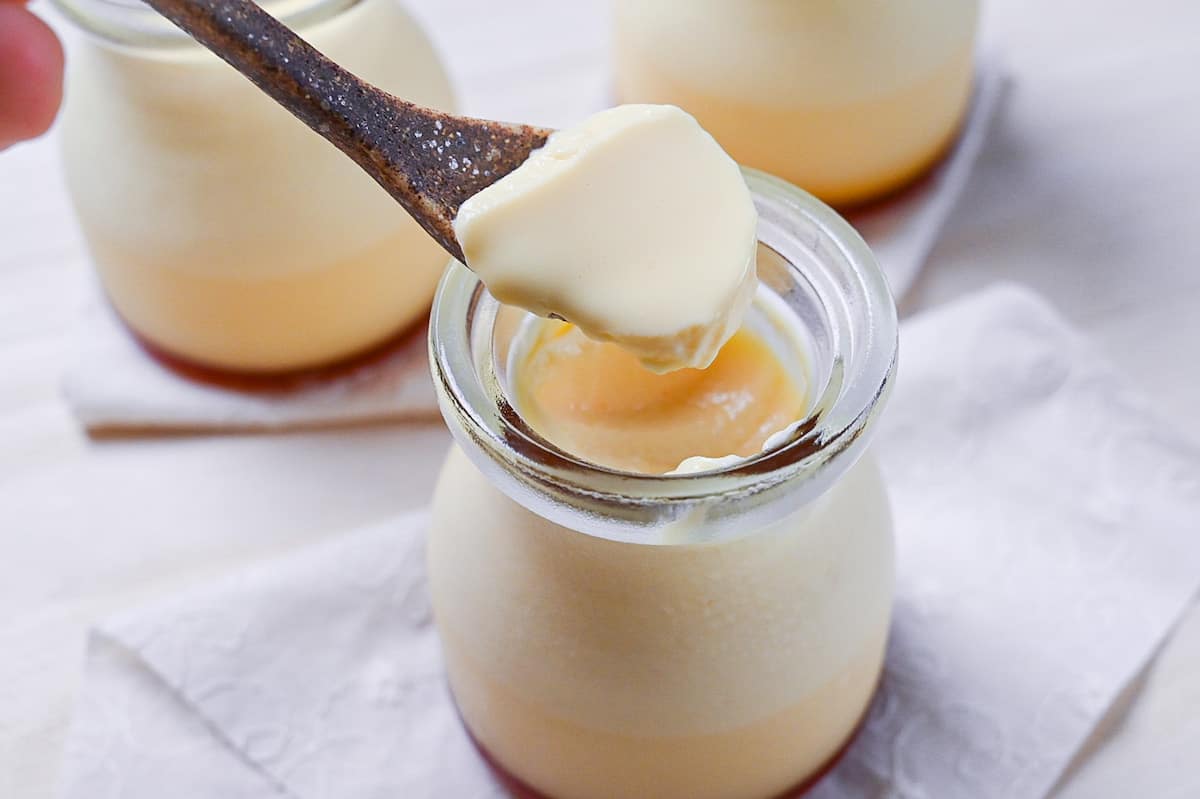
I hope you enjoy this Nameraka Purin recipe! If you try it out, I’d really appreciate it if you could spare a moment to let me know what you thought by giving a review and star rating in the comments below. It’s also helpful to share any adjustments you made to the recipe with our other readers. Thank you!
More Japanese Dessert Recipes
- Sata Andagi (Okinawan Donuts)
- Homemade Matcha Green Tea Ice Cream
- Fudgy Dark Chocolate and Matcha Brownies
- Japanese Style Lemon Rare Cheesecake (no bake)
- Nama Chocolate (Japanese Valentine’s Day Chocolate)
Want more inspiration? Explore my Japanese Dessert Roundup Post for a carefully selected collection of tasty recipe ideas to spark your next tea party!
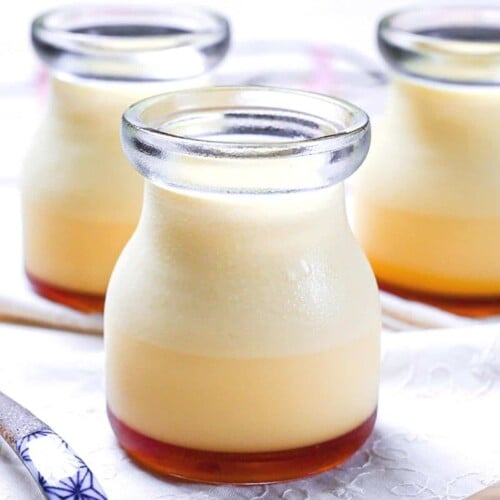
Nameraka Purin (Silky Japanese Custard Pudding)
Equipment
- Purin Cups 6x100ml or 4x150ml
Ingredients
For the caramel
- 50 g white sugar
- 60 ml water
For the custard
- 300 ml whole milk
- 50 g white sugar
- 7 g gelatin powder
- 3 pasteurized egg
- 100 ml heavy cream
- ½ tsp vanilla essence or half the amount of vanilla extract
Instructions
- First, pour 300 ml whole milk into microwavable container and stir in 50 g white sugar and 7 g gelatin powder. Mix and leave the gelatin to bloom for 5-10 minutes. While you wait, make the caramel.

Make the caramel
- Start by measuring out 60 ml water. Add one-third of the water to a cold saucepan along with 50 g white sugar. Mix them together before you turn on the heat.

- Turn on the heat on a medium/medium-low setting and bring to a bubbling state. Do not mix, but feel free to tilt the pan from time to time if the sugar is starting to color unevenly.

- When the sugar and water starts to become a little golden, add another third of the cold water. (Be careful of the caramel splashing and sizzling, I recommend standing back and wearing oven gloves to protect your hands.)

- Continue to heat the caramel and tilt the pan from time to time to ensure even coloring. Once it starts to turn an amber color, add the last third of the water.Take it off the heat and swirl the caramel around by tilting the pan in a circular motion. This will get some air into the caramel and allow it to cool down a bit.

- Pour the caramel into 4-6 heatproof containers and set aside for later. (Once cool, place in the refrigerator to set it further.)

Make the custard
- Microwave the jug of milk, sugar and gelatine from step 1 for 2 minutes at 600W.

- If any grains of gelatine are remaining, continue to heat in the microwave in 20-30 second increments, mixing each time until the gelatine is completely melted. (Be careful not to scold the milk.) Leave to cool slightly.

- Crack 3 pasteurized egg into a heatproof mixing bowl and whisk until the yolks and whites are combined.

- Add 100 ml heavy cream and ½ tsp vanilla essence and whisk again.

- Pour a small amount of the hot milk mixture into the egg mixture and mix to temper the eggs. Add the rest of the milk gradually while whisking gently.

- Rinse out the jug and place a strainer over the top. Pour the custard mixture through the sieve to remove any stubborn lumps of gelatine or egg.

- Pour the custard into the containers, leaving a small space at the top to prevent spills.Cover with lids or plastic wrap and chill in the refrigerator for 3 hours minimum, preferably over night.

- Serve and enjoy!

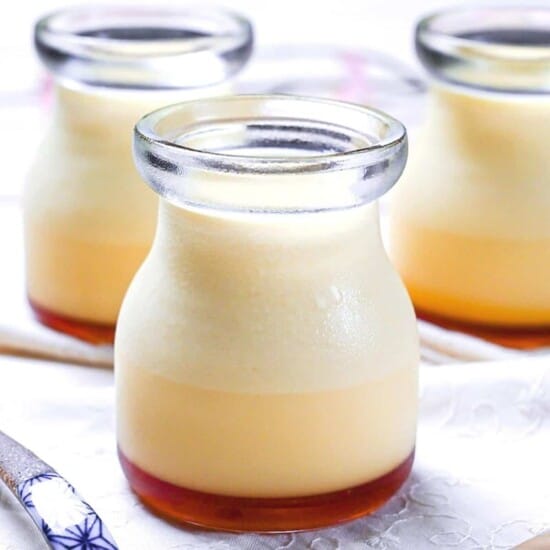



Thank you for this recipe. I have been looking for this for over a year. And now i found yours. I made it yesterday and could not put it down. So good, just perfect. But, i made a sugarfree version of it. So, i used almond milk and heavy cream, with the eggs and gelatine, with stevia drops. And minimal effort too.
Thank you for your comment and generous rating. I’m happy you enjoyed the recipe!
I visited Japan last year and I missed having the puddings there so much!
I already knew how to make flan but the texture of japanese puddings was just so smooth and melt in your mouth that i had to learn how to make it. I looked up so many recipes until I found yours!
And I must say it came out perfect, I even used half of the pudding mixture to make a coffee flavoured one! its such a good base!
I did however have to make the caramel twice, but atleast now I know how to make a a liquidy caramel!
Hi Shruthi, thank you for trying the recipe and sharing your photo, it looks delicious! I’m happy you enjoyed it.
Caramel can be a bit tricky but I’m glad you could make it on your second try. I also love your idea of making coffee flavor, I must try that!
Yuto
I think next time to make a coffee version I will have to figure out a coffee syrup. just mixing it into the base didnt give that strong of a flavour, something about the flavour profile was a bit off without a syrup. Im going to experiment though!
I think lemon syrup might also be nice, kind of like panna cotta flavours but purin texture!
Did you use instant coffee last time? Perhaps you can try adding more instant coffee to the hot milk mixture and use a coffee flavored syrup instead of caramel.
Using powders like coffee or matcha is a good way to change the flavor of the base, I think you’d have to be careful with syrups since they will change the liquid amount and I’m not sure how it will affect the texture. Probably the best thing to do is swap the vanilla essence for other flavor extracts, I know lemon extract is available. I’m also a big fan of lemon so if I try it, I’ll let you know how it goes!
Thank you for your input! Hope you enjoy experimenting with more purin flavors!
ahh, i wanted to try the original flavour as well, so i added a few spoonfuls of strong brewed coffee to half the purin mixture at the end.
I think next time if i want coffee i’ll add the instant powder directly to the milk and try making a coffee syrup!
but essence does make sense for the other flavours, Im going to eventually try with some indian flavours like rose milk and cardamom, my grandma will like it more than coffee for sure
That sounds great!
I love your ideas, they’re very creative and sound delicious!